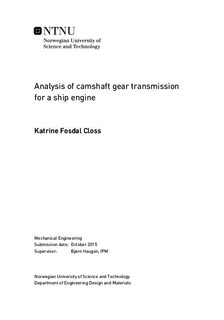Analysis of camshaft gear transmission for a ship engine
Master thesis
Permanent lenke
http://hdl.handle.net/11250/2367836Utgivelsesdato
2015Metadata
Vis full innførselSamlinger
Sammendrag
This thesis investigates the dynamic behavior of a spur gear pair. The gears studiedare somewhat similar to the ones found in Bergen Engines medium-speed dieselengine with regards to design, but some assumptions have been made when it comesto stiffness and damping. Gear components are an important part in advancedmachines and have been a subject of studies due to increasing demands for higherperformance and reliability and noise control.At first a dynamic model of a spur gear including time varying mesh stiffness andbacklash is established in Fedem to be analyzed. The complicated phenomenon oftooth contact alternating between variable number of teeth pairs in contact andthe presents of backlash, cause additional dynamic forces and is the main source ofgear vibration. Backlash is unavoidable but also necessary in gear transmissionpreventing the teeth from jamming and allowing room for lubrication. The effectof backlash cause tooth separation and lead to contact loss during meshing.Parametric studies were conducted to examine the effects of the following variables;backlash, torque and rotational speed. For a system with no backlash, the gearteeth remained in contact throughout the gear mesh and did not experience contactloss or tooth separation. For small values of backlash, the analysis showed zerovalues for the moment which is a result of tooth separation. The time of contactloss increased with increasing value of backlash.For a systems with a given constant backlash, the variation in torque appeared asdifferent values of time of contact loss. For decreasing values of torque the time ofthe tooth separation increased.The analysis clearly shows that the model experience backside contact. Backsidecontact is a result of backlash and fluctuations caused by the time varying meshstiffness due to the contact ratio alternating between number of teeth in contact.When these fluctuations coincide with the natural vibration, resonance occur and results in backside contact.The results were in good agreement with the expectations and analytically showedthe effects off backlash. The gears experience significant dynamic contributions asa cause of backlash and time variant mesh stiffness.
